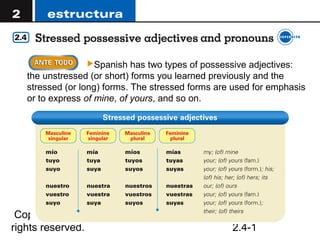More Related Content
More from Andrea Olatunji Olatunji
More from Andrea Olatunji Olatunji (20)
Posesivos
- 1. Spanish has two types of possessive adjectives:
the unstressed (or short) forms you learned previously and the
stressed (or long) forms. The stressed forms are used for emphasis
or to express of mine, of yours, and so on.
Copyright © 2008 Vista Higher Learning. All
rights reserved. 2.4-1
- 2. ¡Atención! Used with un/una, these
possessives are similar in meaning to the
English expression of mine/yours/etc.
Copyright © 2008 Vista Higher Learning. All
rights reserved. 2.4-2
- 3. Stressed possessive adjectives agree in gender and
number with the nouns they modify. Stressed
possessive adjectives are placed after the noun they
modify, while unstressed possessive adjectives are
placed before the noun.
Copyright © 2008 Vista Higher Learning. All
rights reserved. 2.4-3
- 4. A definite article, an indefinite article, or a
demonstrative adjective usually precedes a
noun modified by a stressed possessive
adjective.
Copyright © 2008 Vista Higher Learning. All
rights reserved. 2.4-4
- 5. Since suyo, suya, suyos, and suyas have
more than one meaning, you can avoid
confusion by using the construction:
[article] + [noun] + de + [subject pronoun].
Copyright © 2008 Vista Higher Learning. All
rights reserved. 2.4-5
- 6. Possessive pronouns
Possessive pronouns are used to replace a
noun + [possessive adjective]. In Spanish, the
possessive pronouns have the same forms as
the stressed possessive adjectives, and they
are preceded by a definite article.
Copyright © 2008 Vista Higher Learning. All
rights reserved. 2.4-6
- 7. A possessive pronoun agrees in number and gender
with the noun it replaces.
Copyright © 2008 Vista Higher Learning. All
rights reserved. 2.4-7
- 8. Indica las formas tónicas (stressed) de estos adjetivos
posesivos y los pronombres posesivos correspondientes.
adjetivos pronombres
1. su videocasetera la videocasetera suya
____________ la suya
____________
2. mi televisor ____________ ____________
3. nuestros discos compactos ____________ ____________
4. tus calculadoras ____________ ____________
5. su monitor ____________ ____________
6. mis videos ____________ ____________
7. nuestra impresora ____________ ____________
8. tu estéreo ____________ ____________
9. nuestro cederrón ____________ ____________
10. mi computadora ____________ ____________
Copyright © 2008 Vista Higher Learning. All
rights reserved. 2.4-8
